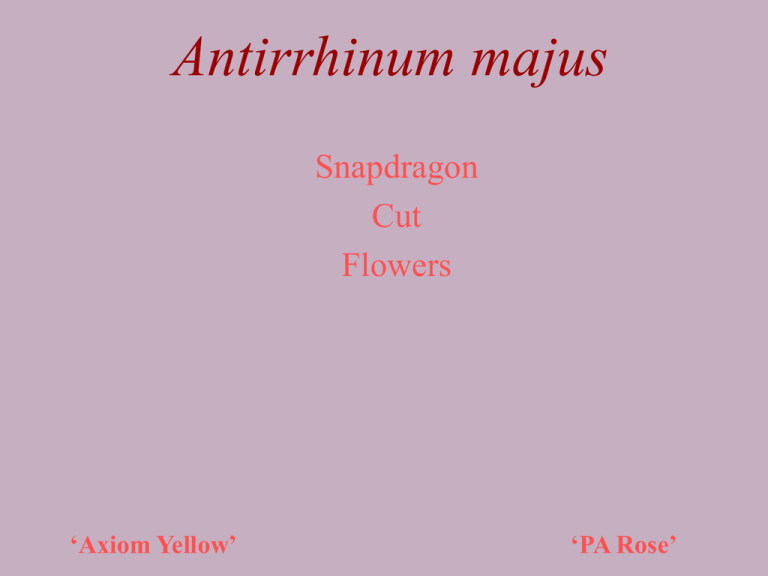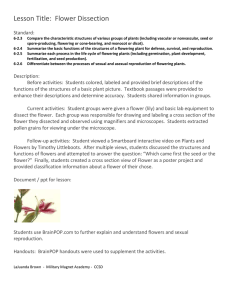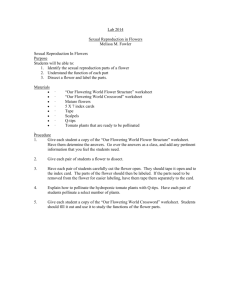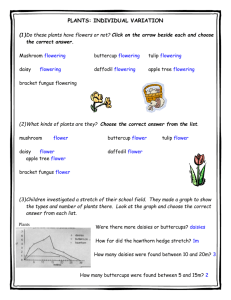Antirrhinum majus Snapdragon Cut Flowers
advertisement

Antirrhinum majus Snapdragon Cut Flowers ‘Axiom Yellow’ ‘PA Rose’ Taxonomy & Origin • • • • Member of Scrophulariaceae 40 species Origin is the Mediterranean area Herbaceous perennial Uses and Sizes • • • • • Cut flowers Garden plants Bedding plants Potted plants Hanging baskets • Dwarf to 36 - 72” • Trailing or upright Colors & Flower Types • • • • • • • White Red Rose Pink Yellow Orange Bicolors • Single • Double • Openfaced (butterfly) Five lobed petals Raceme 2 upper lobes form a mouth Pedicel 3 lower lobes Corolla fused into a tube Perfect flowers Cut Flower Cultivars Flower Time Photoperiod Light Temperature (night) Group 1 SD low 45-500 F SD moderate 50-550 F Winter Don’t need in the South Group 2 Early Spring Group 3 0 LD Mod-high 55-60 F LD High >600 F Spring Group 4 Summer Propagation • • • • Seeds 10 days at 64 - 68 0 F under light Buy plugs from specialists propagator Need high light or supplemental light for best quality Flowering Control • Facultative long day plant. • Flowering occurs faster under long days but can occur under short days. • Juvenile plants (< specified leaf number) will not respond to LD. • When mature enough to perceive LD, temperature effects rate of flower initiation, not development. • Higher temperatures reduce time to flowering. Flowering Control • Once flower initiation has occurred, temperature has little effect on days to flower. • The time between visible flower bud and anthesis is not influenced by light duration or intensity. Temperature • Plants like warm temperatures during early and cool temperatures during later stages of growth. • Usually grown at 50-520F night temp throughout production, however. • When the media is cool and the air is warm the ability of the plant to take up water is restricted and the plants will wilt (on bright, sunny winter mornings). Light • Ability to fix carbon may be the difference between cultivar classifications. • Winter flowering- not delayed by low light and SD because they have a short juvenile phase. • Summer flowering- longer juvenile phase and higher leaf number under LD and high light. Light • High pressure sodium lamps decrease time to flower and increase quality when used to supplement light in the winter. • Most economical if used in the seedling stage of growth because plant density is higher. • Incandescent lighting can also be used to extend the day to 18 hour or use night interruption. Snapdragon Culture • Do not overwater! • Overwatering and Pythium root rot go hand-inhand. • Ground beds should be at least 6 inches deep to allow for adequate drainage. • Group I and II responsive to CO2 during the winter. Snapdragon Culture con’t • Low nutrient requirement compared to poinsettias and chrysanthemums. • 100 ppm constant liquid feed. • Nitrate N is preferred to ammonium. • Sensitive to low levels of Boron and it must be present (B becomes deficient when Ca levels are too high). Snapdragon Culture con’t • Aphids are a major insect pest. • Sanitation, soil treatment, air movement, humidity control help to reduce disease damage. • Cut flowers can be grown single stemmed or pinched. • Potted plants may need to be pinched. • Bonzi drench for height control in potted flowering plants. Scheduling and Timing Based on cultivar and time of year: If cultivar is not properly selected for a particular time of year 1. Flowering problems will occur delayed or accelerated 2. Vegetative problems will also occur small, weak plants vs. large, grassy plants Postharvest • Harvest cut flowers when 1/3 of inflorescence is open. • Preservatives can double vase life. • Sensitive to ethylene - one-hour pulse of STS at room temperature.



